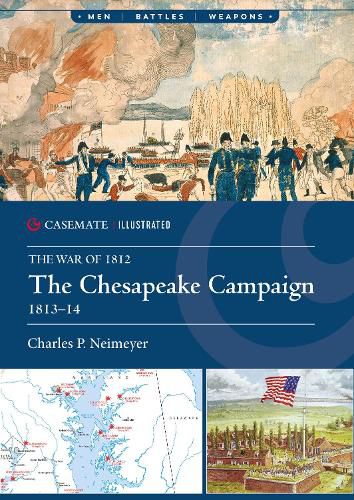Readings Newsletter
Become a Readings Member to make your shopping experience even easier.
Sign in or sign up for free!
You’re not far away from qualifying for FREE standard shipping within Australia
You’ve qualified for FREE standard shipping within Australia
The cart is loading…






In early 1813, Britain launched a campaign on the Chesapeake Bay to try and divert American regulars from the Canadian border and put pressure on the United States to come to terms. Wishing to keep the Regular Army on the northern front, Secretary of War John Armstrong chose to rely on local forces and state militias to protect the Chesapeake Bay region, believing British raids posed more of a distraction than a serious threat. This defensive approach meant that towns, ports, and even the nation's capital were left vulnerable to attack, and the responsibility for protection largely fell to less experienced, hastily organized militia units. While American forces successfully defended Craney Island near Norfolk, staving off British occupation, British forces routed an American force at Bladenburg, opening the path to Washington, where they set fire to public buildings, including the White House and the Capitol. This symbolic victory was followed by the Battle of North Point and the defense of Fort McHenry, where Americans managed to turn back British forces in Baltimore. Although the British raid on Washington was a symbolic coup, it did not disrupt the U.S. government or significantly affect the war. The failed attempt to capture Baltimore, combined with a decisive American victory at Plattsburgh, New York, underscored American resilience and contributed to Britain's decision to end the war without any territorial concessions. Illustrated with photographs and maps, The U.S. Army in the Chesapeake Campaign 1813?14 examines this campaign's key engagements. AUTHOR: Charles P. Neimeyer, a retired Marine Corps officer, is the director of Marine Corps History and the Gray Research Center at the Marine Corps University, Quantico, Virginia. He holds a Ph.D. in history from Georgetown University. His publications include America Goes to War: A Social History of the Continental Army (1996), The Revolutionary War (2007), and On the Corps: USMC Wisdom from the Pages of Leatherneck, Marine Corps Gazette, and Proceedings (2008).
$9.00 standard shipping within Australia
FREE standard shipping within Australia for orders over $100.00
Express & International shipping calculated at checkout
In early 1813, Britain launched a campaign on the Chesapeake Bay to try and divert American regulars from the Canadian border and put pressure on the United States to come to terms. Wishing to keep the Regular Army on the northern front, Secretary of War John Armstrong chose to rely on local forces and state militias to protect the Chesapeake Bay region, believing British raids posed more of a distraction than a serious threat. This defensive approach meant that towns, ports, and even the nation's capital were left vulnerable to attack, and the responsibility for protection largely fell to less experienced, hastily organized militia units. While American forces successfully defended Craney Island near Norfolk, staving off British occupation, British forces routed an American force at Bladenburg, opening the path to Washington, where they set fire to public buildings, including the White House and the Capitol. This symbolic victory was followed by the Battle of North Point and the defense of Fort McHenry, where Americans managed to turn back British forces in Baltimore. Although the British raid on Washington was a symbolic coup, it did not disrupt the U.S. government or significantly affect the war. The failed attempt to capture Baltimore, combined with a decisive American victory at Plattsburgh, New York, underscored American resilience and contributed to Britain's decision to end the war without any territorial concessions. Illustrated with photographs and maps, The U.S. Army in the Chesapeake Campaign 1813?14 examines this campaign's key engagements. AUTHOR: Charles P. Neimeyer, a retired Marine Corps officer, is the director of Marine Corps History and the Gray Research Center at the Marine Corps University, Quantico, Virginia. He holds a Ph.D. in history from Georgetown University. His publications include America Goes to War: A Social History of the Continental Army (1996), The Revolutionary War (2007), and On the Corps: USMC Wisdom from the Pages of Leatherneck, Marine Corps Gazette, and Proceedings (2008).